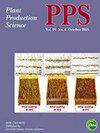Comparison of anthocyanin and polyphenolics in purple sweetpotato (Ipomoea batatas Lam.) grown in different locations in Japan
IF 1.3
3区 农林科学
Q2 AGRONOMY
引用次数: 0
Abstract
ABSTRACT The health benefits of purple sweetpotato, which is used as an edible food in its natural state and in processed foods and as a natural color pigment, have been recognized. In Japan, sweetpotato has been economically produced in regions below 36°4ʹN latitude; however, cultivation areas are beginning to expand further north. The anthocyanin and polyphenolics in three purple sweetpotatoes cultivated in different locations; I (42°92ʹN, 143°04ʹE) and II (31°72ʹN, 131°03ʹE), were compared over two years. Total anthocyanin and polyphenolic contents in purple sweetpotatoes tended to be high in location I. The anthocyanin and polyphenolic compositions differed between locations. The peonidin/cyanidin ratios were higher in location II compared with I in all varieties. The relative amount of 3,4- and 4,5-di-O-caffeoyolquinic acids were higher in location II. Their contents and composition also differed between years. These results suggest that the variability of the anthocyanin and polyphenolic content and composition was influenced by climate conditions, probably temperature during cultivation. This study indicates that northern areas in Japan are an alternative production area and may yield higher amounts of anthocyanin and polyphenolics. Graphical abstract日本不同产地紫甘薯(Ipomoea batatas Lam.)花青素和多酚类物质的比较
摘要紫甘薯是一种天然食用食品和加工食品,也是一种天然色素。在日本,红薯在北纬36°4°以下的地区进行了经济生产;然而,种植面积开始进一步向北扩展。不同产地栽培的三种紫甘薯的花青素和多酚类物质;I(42°92°N,143°04°E)和II(31°72°N,131°03°E)在两年内进行了比较。紫甘薯的总花青素和多酚含量在Ⅰ区较高。不同部位的花青素和多酚组成不同。在所有品种中,位置II的牡丹苷/矢车菊素比率均高于位置I。位置II中3,4-和4,5-二-O-咖啡酸的相对量较高。它们的内容和组成也因年份而异。这些结果表明,花青素和多酚含量和组成的变化受到气候条件的影响,可能是栽培过程中的温度。这项研究表明,日本北部地区是一个替代生产地区,可能会产生更高数量的花青素和多酚。图形摘要
本文章由计算机程序翻译,如有差异,请以英文原文为准。
求助全文
约1分钟内获得全文
求助全文
来源期刊

Plant Production Science
农林科学-农艺学
CiteScore
5.10
自引率
4.00%
发文量
27
审稿时长
>36 weeks
期刊介绍:
Plant Production Science publishes original research reports on field crops and resource plants, their production and related subjects, covering a wide range of sciences; physiology, biotechnology, morphology, ecology, cropping system, production technology and post harvest management. Studies on plant production with special attention to resource management and the environment are also welcome. Field surveys on cropping or farming system are also accepted. Articles with a background in other research areas such as soil science, meteorology, biometry, product process and plant protection will be accepted as long as they are significantly related to plant production.
 求助内容:
求助内容: 应助结果提醒方式:
应助结果提醒方式:


